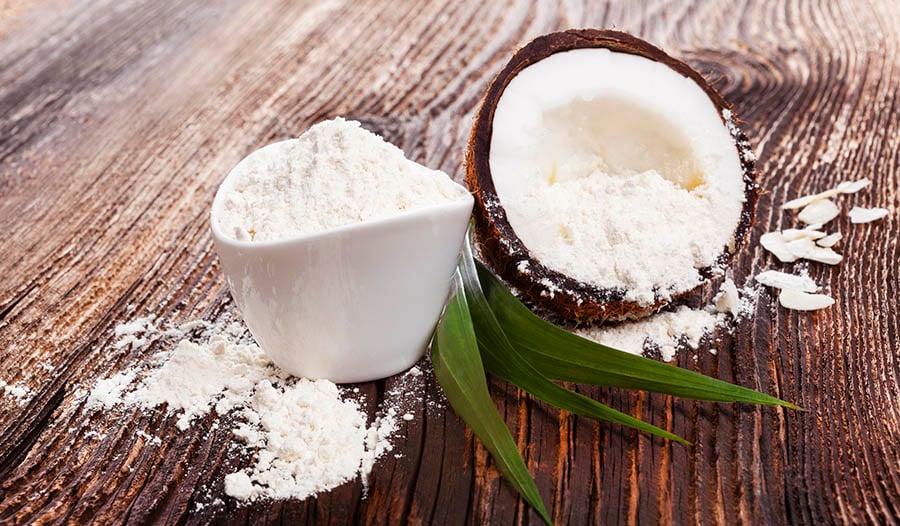3 Gluten-Free Flours, Health Benefits, and Recipes
DISCLAIMER:This blog does not intend to provide diagnosis...
- In this article:
- 1. Coconut Flour
- Gluten-Free Chocolate Coconut Cake With Hot Fudge Sauce
- 2. Almond Flour
- Almond Flour Blueberry Bread Recipe
- 3. Brown Rice Flour
- Brown Rice Zucchini Fritter Recipe

Originally posted June 2018 / Updated January 2023
Many people are avoiding gluten consumption for a variety of different reasons. Gluten is a protein complex found in wheat and related grains such as barley, spelt, and rye. In sensitive individuals, gluten can produce an array of symptoms, but generally gastrointestinal (GI) issues ranging from very mild GI discomfort such as gas, bloating, and mild discomfort to more severe symptoms such as diarrhea and malabsorption.
There are several alternatives to wheat and other gluten-containing flour. Among the most popular are coconut, almond, and brown rice flour. These gluten-free flours offer some unique flavors in cooking recipes for dinner and dessert and, in the process, create great-tasting, healthy meals at home. different types of flour may assist cooks in making healthier meals for themselves and their families.
1. Coconut Flour
Coconut flour is made from coconut meat and contains no grains or nuts. It is made by separating the meat from the milk. The meat is then baked at a low temperature until it becomes powdery. This gluten-free alternative may help balance metabolism because the medium-chain fatty acids give it a high level of healthy saturated fats. Coconut flour is also high in both soluble and insoluble fiber. As a result, it helps promote regularity, eliminate toxins from the body, and lower blood cholesterol levels.1 Coconut flour has a low glycemic index and is an excellent alternative for those who need nutritional support to help control blood sugar levels or those trying to lose weight.2
Here is a recipe for chocolate coconut cake with hot fudge sauce that is a great place to start using coconut flour.
Gluten-Free Chocolate Coconut Cake With Hot Fudge Sauce
Ingredients:
- 1 tsp. baking powder
- 1/2 cup coconut flour
- 1/2 cup cocoa powder
- 6 Tbs. butter
- 3/4 cup sugar (or 1 cup allulose)
- 1/2 tsp. salt
- 1 Tbs. plus 1 tsp. vanilla extract, divided
- 3 cups unsweetened applesauce
- 1/2 cup raw honey or agave syrup
- 1 cup water
- 1/2 cup coconut oil
Instructions:
- Preheat oven to 350 degrees Fahrenheit.
- Grease an 8-inch cake pan.
- Sift together baking powder and coconut flour. Stir until well-combined and set aside.
- Place cocoa and butter in a microwave-safe bowl. Heat in microwave until butter melts.
- Add sugar or allulose, salt, 1 tsp. vanilla extract and unsweetened applesauce to the cocoa-butter mixture. Whisk until well combined.
- Add the baking powder and coconut flour. Stir until well combined.
- Place batter in square cake pan. Let rest 12 minutes.
- Bake for 30 minutes until a cake tester comes out clean.
- Cool cake for 30 minutes.
2. Almond Flour
Almond flour is another popular alternative to wheat flour that you will want to try. It is made simply by grinding the almonds into a powder. Since it takes about 90 almonds to make 1 cup of flour, all of the health benefits noted for almonds are concentrated in almond flour. Almonds are well-known as a nutritional powerhouse. Adding almond flour to baked goods dramatically increases the nutritional profile of the food, especially for protein, magnesium, and healthy fats. And studies suggest that eating almonds or almond flour produces multiple health benefits such as lowering cholesterol and promoting the health of blood vessels to reduce blood pressure and heart disease.3,4 Almond flour consumption also improves the health and function of the gastrointestinal tract.4,5
There are a lot of good health reasons to give almond flour-based recipes a try. Here is one to get you started:
Almond Flour Blueberry Bread Recipe
Ingredients:
- 1 1/2 cups almond flour
- 4 eggs
- 2 Tbs. olive oil
- 2 tsp. baking powder
- 1/3 cup flaxseed meal
- 1/4 cup unsweetened almond milk
- 1 tsp. cinnamon
- 1 tsp. stevia powder
- 1/2 tsp. salt
- 2/3 cup fresh blueberries
Instructions:
- Preheat oven to 350 degrees Fahrenheit.
- Grease loaf pan.
- Mix together all ingredients except blueberries. Beat until a smooth dough forms.
- Add blueberries. Stir until well-distributed.
- Bake in oven for about 40 minutes until top is golden brown.
- Let sit in the pan for 10 minutes.
- Turn out on a wire rack.
- Let sit until completely cool. Slice and enjoy.
3. Brown Rice Flour
Rice flour is a popular gluten-free alternative, but brown rice powder provides significantly more nutritional value and dietary fiber. Brown rice flour is made by removing the outer hull and grinding the entire grain of rice, including the valuable bran and germ. With regular white rice, it is only the starchy endosperm of the grain that is ground. Brown rice flour is still gluten-free but much higher in dietary fiber, magnesium, trace minerals, and B vitamins than white rice flour. And unlike coconut and almond flour, brown rice flour has only a trace amount of fat.
Since brown rice flour is made from ground brown rice, all of the health benefits noted for brown rice regularly apply to this flour. In addition to a higher nutritional profile and fiber content than white rice, brown rice is rich in many other compounds with health-promoting effects, such as inositol, gamma-aminobutyric acid (GABA), γ-oryzanol, and flavonoids. Brown rice flour consumption can lower blood cholesterol levels and has a much lower impact on blood sugar levels than white rice flour. Eating more brown rice foods is also linked to a protective effect against diabetes and obesity.6
Here is a brown rice flour recipe that combines the health benefits of brown rice with other powerfully beneficial ingredients:
Brown Rice Zucchini Fritter Recipe
Ingredients:
- 1 Tbs. flaxseed
- 2 Tbs. warm water
- 1 large zucchini
- 1/2 tsp. salt
- 1/8 tsp. ground black pepper
- 1 tsp. ground cumin
- 1/4 tsp. garlic salt
- 1/8 tsp. chili powder
- 1/3 cup brown rice flour
- 2 tsp. nutritional yeast
- 1 tsp. coconut oil
Instructions:
- Combine the flaxseed and water in a small bowl. Let sit for 10 minutes.
- Finely shred the zucchini.
- Add remaining ingredients except coconut oil to zucchini. Stir to combine well.
- Add flaxseed mixture. Stir to combine well.
- Heat coconut oil in a skillet over medium-high heat.
- Form mixture into four patties in the palm of the hand.
- Reduce heat to medium-low.
- Place patties in the skillet. Fry for four minutes.
- Flip patties over and fry until crispy.
References:
- Trinidad TP, Loyola AS, Mallillin AC, Valdez DH, Askali FC, Castillo JC, Resaba RL, Masa DB. The cholesterol-lowering effect of coconut flakes in humans with moderately raised serum cholesterol. J Med Food. 2004 Summer;7(2):136-40.
- Trinidad TP, Valdez DH, Loyola AS, Mallillin AC, Askali FC, Castillo JC, Masa DB. Glycaemic index of different coconut (Cocos nucifera)-flour products in normal and diabetic subjects. Br J Nutr. 2003 Sep;90(3):551-6.
- Musa-Veloso K, Paulionis L, Poon T, Lee HY. The effects of almond consumption on fasting blood lipid levels: a systematic review and meta-analysis of randomised controlled trials. J Nutr Sci. 2016 Aug 16;5:e34.
- Dreher ML. A Comprehensive Review of Almond Clinical Trials on Weight Measures, Metabolic Health Biomarkers and Outcomes, and the Gut Microbiota. Nutrients. 2021 Jun 8;13(6):1968.
- Creedon AC, Dimidi E, Hung ES, Rossi M, Probert C, Grassby T, Miguens-Blanco J, Marchesi JR, Scott SM, Berry SE, Whelan K. The impact of almonds and almond processing on gastrointestinal physiology, luminal microbiology, and gastrointestinal symptoms: a randomized controlled trial and mastication study. Am J Clin Nutr. 2022 Dec 19;116(6):1790-1804.
- Cheng Z, Qiao D, Zhao S, Zhang B, Lin Q, Xie F. Whole grain rice: Updated understanding of starch digestibility and the regulation of glucose and lipid metabolism. Compr Rev Food Sci Food Saf. 2022 Jul;21(4):3244-3273.

 By Dr. Michael Murray, N.D.
By Dr. Michael Murray, N.D. 


